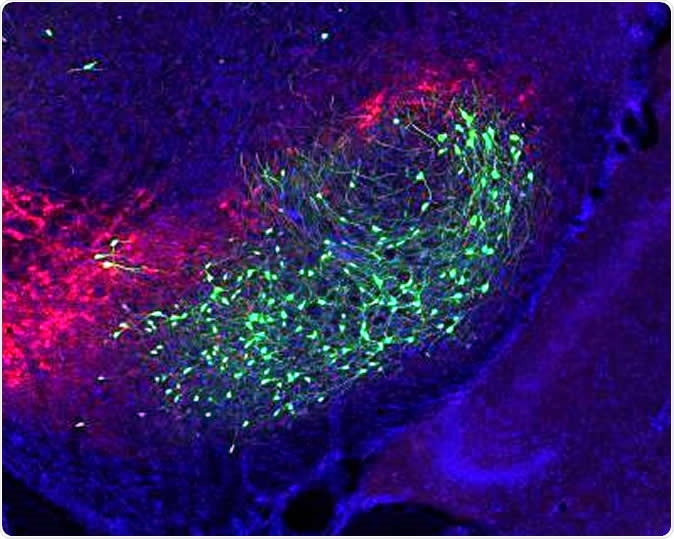The brain is a powerful organ that controls all the body processes, including movement. In some athletes, however, they usually experience a phenomenon called “choking,” wherein their performance rapidly declines when they’re under a lot of pressure.
The exact mechanism of choking has been widely studied, but now, new highlights emerged, thanks to a new study by researchers at Salk Institute. The study, which was published in the journal eLife, shows that one-way signals from the emotion circuit of the brain go to the movement circuit, making emotions affect action.

A cluster of basal ganglia output neurons (green) that convey emotion information to the movement circuit to control action. Dopaminergic neurons (red) are also present in the image. Image Credit: Salk Institute / Shutterstock
The new study could pave the way for the formulation of new treatment strategies for treating diseases with disruptive movement, including anxiety, depression, and obsessive-compulsive disorder. The new body of knowledge can also contribute to the therapy for people with spinal cord injuries, or among athletes who experience altered physical performance when they face high-stress situations.
“This finding is very exciting as it is the first time that a comprehensive circuit mechanism has been found showing how emotional states can influence movement through connections in an area of the brain called the basal ganglia, a region involved in guiding behavior," Xin Jin, study’s lead author, said in a statement.
"We did not previously know much about this pathway, so it brings about a whole new paradigm for examining psychiatric disorders as well as spinal cord injury,” he added.
How emotion information reaches the movement circuitry in the brain
The cortico-basal ganglia circuits are important for cognitive, emotional, and sensorimotor functions. In the past, it was known that the brain’s emotional and movement loops are parallel and closed circuits. This means that they do not interact with each other or affect each other.
However, the researchers in the current study suspected that there could be some influence of emotion on movement. They believe there is a relationship between the two because in many neuropsychiatric disorders such as depression, one of the main symptoms is decreased physical movement. The scientists believe that the altered movement patterns in people with depression stem from disrupted emotional processing and decreased motivation.
“We wanted to explore how emotion information reaches the movement circuitry in the brain by using a combination of cutting-edge viral and optogenetic techniques," Sho Aoki, co-author of the study, said.
Mapping the limbic and motor cortico-basal ganglia loops
To land their findings, the researchers mapped the limbic and motor cortico-basal ganglia-thalamocortical loops in laboratory mice. They found that a unidirectional influence of the limbic circuit over the motor loop through the ventral striatum-substansia nigra (SNr)-motor thalamus circuitry.
The researchers traced the circuits to explore the process of neuronal communication. The team focused on both the emotion and action or movement loops. They found a one-way communication pathway from the emotion loop to the movement loop in the basal ganglia, a deep area in the brain. For confirmation, the team used a method called optogenetics, which utilizes light for cell control. This method helped them study the exact function of the neurons in the said region of the brain.
“This is an elegant example demonstrating that we are in a new era of studying brain circuits in ever more refined detail,” Daofen Chen, program director at the NIH’s National Institute of Neurological Disorders and Stroke, said.
“As a result of emerging technologies and novel tools, we are gaining new insights into mechanisms of brain disorders,” he added.
The study will help for future therapies and strategies to address conditions, like psychiatric diseases.
“Psychiatric diseases such as depression and anxiety can alter actions in a dramatic way by either decreasing or increasing movement. This mechanism represents a likely way that emotional states are related to changes in action control in psychiatric diseases," Jin added.
The researchers also believe that their study can help patients with spinal cord injury.
The National Institutes of Health, the Dana Foundation, the Ellison Medical Foundation, and the Whitehall Foundation, supported and funded the study.
Journal reference:
Aoki, S., Smith, J., Li, H., Yan, X., Igarashi, M., Coulon, P., Wickens, J., Ruigok, T., and Jin, X. (2019). An open cortico-basal ganglia loop allows limbic control over motor output via the nigrothalamic pathway. eLife. https://elifesciences.org/articles/49995